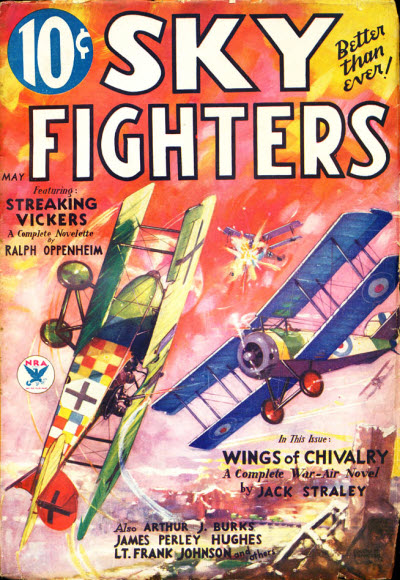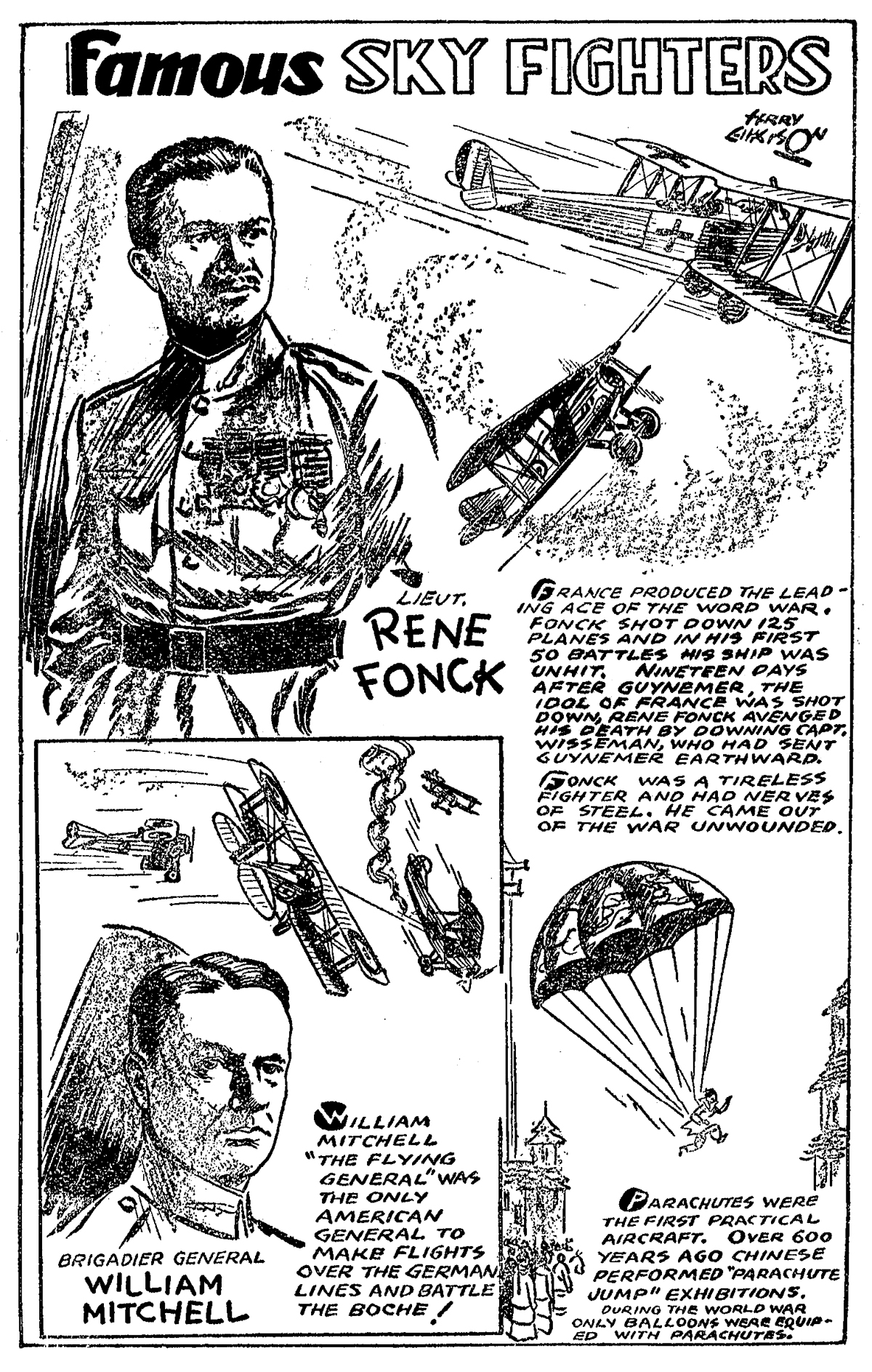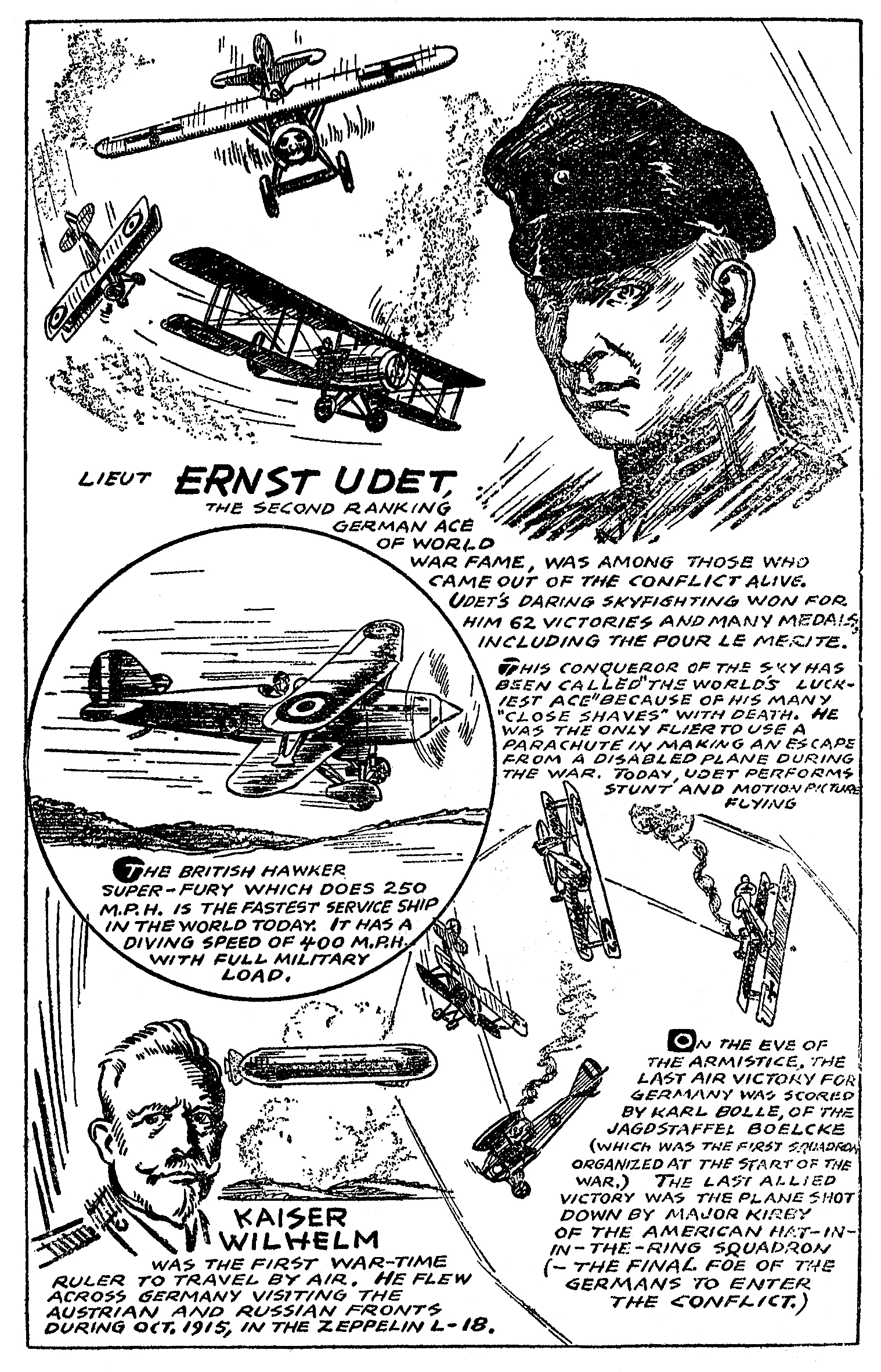How the War Crates Flew: Aerial Armament
FROM the pages of the May 1934 number of Sky Fighters:
Editor’s Note: We feel that this  magazine has been exceedingly fortunate in securing Lt. Edward McCrae to conduct a technical department each month. It is Lt. Mcrae’s idea to tell us the underlying principles and facts concerning expressions and ideas of air-war terminology. Each month he will enlarge upon some particular statement in the stories of this magazine. Lt. MaCrae is qualified for this work, not only because he was a war pilot, but also because he is the editor of this fine magazine.
magazine has been exceedingly fortunate in securing Lt. Edward McCrae to conduct a technical department each month. It is Lt. Mcrae’s idea to tell us the underlying principles and facts concerning expressions and ideas of air-war terminology. Each month he will enlarge upon some particular statement in the stories of this magazine. Lt. MaCrae is qualified for this work, not only because he was a war pilot, but also because he is the editor of this fine magazine.
Aerial Armament
by Lt. Edward McCrae (Sky Fighters, May 1934)
NOW if you featherless kiwis will perch yourselves on the back of those chairs across the room, I’ll tell you some things you didn’t know about how all of this aerial warfare started. It would almost make you laugh, but don’t try it while I’m talking.
A few pre-war aviators had been preaching the virtues of the flying machine as a weapon of war, but the lawmakers with their customary brilliance laughed at the idea and dismissed it. However, they got wise to themselves pretty quickly when the guns started booming.
Airplanes, even though they were winged box-cars, proved invaluable for scouting, dropping bombs by hand, and dropping propaganda literature in enemy territory. And during the first months of the war you couldn’t knock down one of these machines either from the ground or from other airplanes! You dodged ’em and liked it.
He Thumbed His Nose At ’Em
You’ll remember that the German, Immelmann, flew low over Paris every afternoon at cocktail time during a certain period early in the war, and dropped small bombs on the Frenchmen’s conks. People in the street fired millions of shots at him with rifles and pistols. Even taxi drivers stopped their machines while they and their passengers got out and peppered away at the old boy, but he just thumbed his nose at them and showed them his tail.
That’s what we had to buck up against. And then Roland Garros got mad and changed the whole show. Here’s how:
Now if your brains aren’t too dusty you’ll remember that old-time French aviator Garros had already become a hero. But the Germans in the air were interfering with his business of diving down upon enemy factories and bridges, etc., so he decided to interfere with them for a change.
Some InventionI
Up until that time the nose of an airplane was the safest blind spot of all, for if any solid substance touched the whirling propeller, the blade was more than likely done for.
But that old pal of mine, Garros, made it about as safe as the action end of a mule. He invented a machine-gun that would fire through the propeller, and on that day on the nose of a ship ceased being a blind spot and became its business end—the opposite one from that of a hornet.
Before the Germans could realize what had happened, little Roland had tickled five of them in the ribs with bullets.
The Boche Took It Over
And while we’re on the subject of mules—the Germans got the horse laugh on him. While Garros was on one of his famous raids his motor conked, and he and his machine fell into the hands of the Germans before he could destroy it. Thus he delivered to his enemy the very device he had perfected for the purpose of destroying them.
They took over his invention and put it to good use, as you will see.
Now stay awake a little longer, sister, and see why this most famous of French flyers made the greatest of all single contributions to aerial warfare.
When the war broke out in 1914 we heroes were armed with a short rifle. Some of us even carried shotguns!
This sounds rather silly, but they were better than no weapons at all. And don’t I know it! They were of very little value, however, because you couldn’t hit the side of a barn with them. The wind blew against the extended barrel when you aimed them and the ship vibrated so much that you couldn’t have hit your own wing with them from your cockpit.
Did you say that carrying a shotgun was silly, Mabel? Well, listen to this:
Why, you dumb chicks—we carried brick-bats—and that’s no kidding.
Silly? The French brought down two German airplanes with these alley apples!
A Brick-Bat Hero
The idea was to get close enough to the other ship to drop or hurl a piece of this Irish confetti through the other man’s propeller and shove his nose in the mud. Your Uncle Dudley was a brick-bat hero.
Then just a month before Garros invented his gun, the French armed their fighting Nieuports with twenty-pound Lewis guns on their upper wings. Take a squint at Figure 1. The gun was mounted parallel with the line of flight and fired over the top of the propeller. It was aimed by pointing the airplane itself, and was fired by the flyer in the cockpit pulling a string. It was a great improvement over brick-bats, and the Germans quickly adopted it. But a magazine held only forty-seven cartridges and when the flyer had used them up he had to make a landing to reload.
Then up pops our hero Mr. Garros! He mounted his new invention on the engine hood so you could get your hands on it. The gun shot through the arc of the propeller blade. He learned by experimenting that only seven per cent of his bullets would hit his propeller. So he protected the propeller blades with steel bands and let ’em hit.
What a Gun!
The bands reduced the efficiency of his propeller but, “Voila!†He had a gun that was a gun. And he sighted it much to the misery of the Germans, until they got their hands on him.
Six months later the Germans, using the Frenchman’s invention, improved it by synchronizing the action of the trigger with the propeller shaft. From that day to this there hasn’t been much picnicking in the air. Now, my little hollow-heads, take out your slates and listen to some arithmetic. You ought to know this without being told.
A Simple Principle
The principle of the synchronising of the machine-gun is very simple. If a single two-blade propeller revolves before the nose of a gun at the rate of 1,500 revolutions a minute, a blade of the propeller will pass the muzzle 3,000 times. But there are also 3,000 empty spaces where there is no propeller blade in front of the gun. Now, if the gun fires 500 shots a minute it is a simple mechanical problem to operate the weapon mechanically from the motor, so that the gun fires once through every sixth of those empty spaces.
The Germans’ well known Fokker was the first ship to blossom out with one of these new-fangled weapons. But the same thing happened to one of Tony’s ships that happened to Garros’. A Fokker sat down to rest among the Allies, and very soon Spads, Camels and all manners of Allied planes adorned themselves with this new decoration. And today it is more in style than ever.
A New Toy For Peelots
It was more than two years before anybody could think of a new toy for the flyers to play with. Again it was a French Ace, who was later to die with fifty-three victories to his credit, second in France only to Rene Fonck, who thought up this cute little gadget.
Georges Guynemer converted the front end of his crank shaft into a hundred-and-fifty-pound cannon! It fired one-pound shells of several types.
Guynemer worked a long time on this gun and did much to perfect it. With it he brought down his forty-ninth, fiftieth, fifty-first and fifty-second antagonists. The shell was too large to be safely fired between the propeller blades, so it was designed to shoot through the hub itself. Look out for it in Figure 2.
The gun was built into the crank case, and its breech and shootingmechanism were within easy reach, while the muzzle of the gun protruded through the hollow propeller shaft for a distance of two inches beyond.
Semi-Automatic
To begin with, it was semi-automatic, the gun ejecting the empty shell, but the pilot reloading. This work required several seconds, and an airplane traveling at 150 miles an hour could be hopping out of tne range at the rate of 220 feet a second. By the time a flyer got his gun loaded he might find positions reversed and his enemy in charge of the situation.
So they worked this out and eventually developed an arm that would fire 120 shells a minute, each weighing a pound and a half. The catch in the use of this gun, however, was that it would shoot 180 pounds of ammunition a minute and itself weighed 150 pounds. It would take a flying freight train to carry enough ammunition to last it very long. Also, all this weight naturally slowed down the machine. A man with a light ship, a twelve-pound gun shooting rifle cartridges could fly circles around him. But when you hit a ship with your cannon that ship stayed hit.
So it was that as soon as the airplane had established itself as a supreme weapon of war, more attention was given to the effectiveness of its guns.
The Hague Convention had agreed that no explosive projectiles of size less than one-pounders should be used in civilized warfare in order to avoid unnecessary human suffering. But very early in the fighting, two American boys in the famous Lafayette Escadrille were shot with explosive machine-gun bullets! The Germans claim that the British first started breaking the rule and that they used them in retaliation. Naturally!
A Strange Weapon
Thus it was that there was a constant search for the best and most destructive weapon. I once tried out the strangest gun that ever perched on a war crate. It was a one-pounder for seaplanes, and it shot a charge out of both ends of the barrel at the same time! And my name is not Ripley! Nor Baron Munchausen!
The barrel was extremely long (see Figure 3) and the shell was inserted in the side at the middle of its length. The regular projectile was aimed downward at an angle while the other one was discharged backward over the ship. The latter consisted of a mixture of heavy grease and very small shot and was for the sole purpose of offsetting the recoil of the gun. On its flight through the air the grease caught fire and destroyed the tiny shot.
Now you kiwis can hop down off your perches and go out and chirp about your knowledge of gunnery. And try to get through talking before I get back next month.
P.S.—You might be interested to know that the Germans had such a hard time holding Roland Garros prisoner that they made him sign a book in the prison office every thirty minutes for two years. But he finally escaped and went back to fight some more.

















